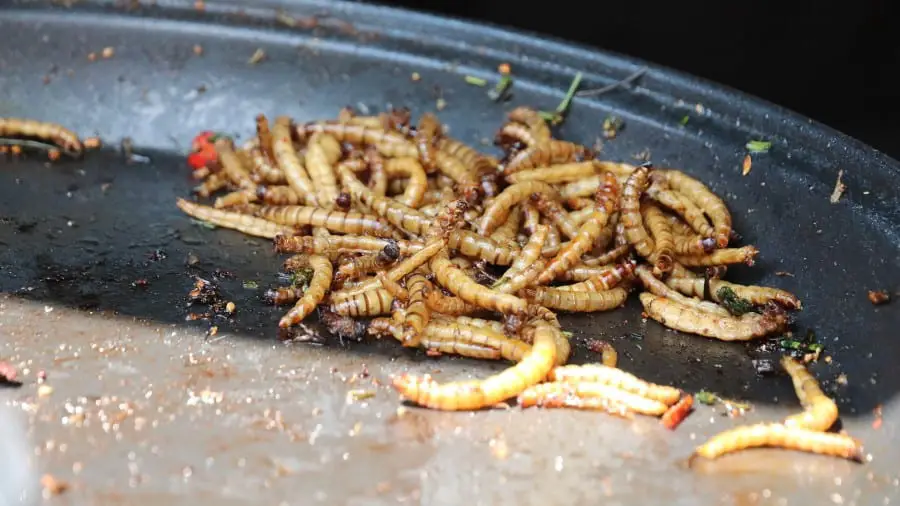
Mealworms are one of the staple foods for many other reptiles in the same category as chameleons. They are found in abundance in pet stores and have been the first choice for many pet owners due to their nutritional and financial value. With that said, can chameleons eat mealworms?
Chameleons can eat mealworms, they are a great choice for live food due to their amazing nutrition. Mealworms are very beneficial for chameleons and are very easy to get as well as being cheaper than other alternatives. They are a great way to supplement your chameleon’s current diet.
Most of the time, your chameleon won’t’ get enough nutrition just from their usual live food alone. Mealworms are always recommended for pet owners to add to their chameleon’s diet so that they can stay fit and healthy. With that said, why are mealworms good for chameleons?
Why Are Mealworms Good for Chameleons?
A chameleon usually doesn’t get enough nutrition from its diet. This is why it is important to include a wide variety of choices for your chameleon to fill up the gaps in their nutrients.
Mealworms are a great choice to balance out all the nutrients they need to thrive. In the wild, the insects that chameleons eat are usually packed with nutrients because they have access to every vitamin and mineral.
These insects will then transfer all their nutrition to the chameleon. However, chameleons in a domestic setting will have to rely on the insects their owners feed them, which are usually only bred as live food.
Hence why they will not get enough nutrition from eating one kind of insect alone. Another thing to note is that chameleons usually get fed up when eating the same thing over and over.
Including more variety in their diet, like mealworms, can keep their meals exciting and keep them invested in eating.
Benefits Chameleons Can Get From Eating Mealworms
As mentioned above, mealworms are quite beneficial to chameleons. I strongly believe every chameleon owner should include it in their chameleon’s diet.
Here are some of the benefits a chameleon can get from eating mealworms.
Protein
Mealworms are packed with protein for their small size. They contain about 20% protein which isn’t the most but is still one of the best when compared to many other live foods.
Protein is one of the three essential macronutrients that are necessities to live, not just to grow. Moreover, protein is used by the body to build new cells and repair whatever damage is done to it.
With a high protein diet, injuries sustained will heal before you know it. Furthermore, it is also used to grow the body since more cells are created using this macronutrient. A lack of protein can stunt growth and cause injuries to heal much slower.
Moisture
Chameleons are very bad at drinking water which makes them very susceptible to dehydration. A dehydrated chameleon is vulnerable to a plethora of problems that range from health to physical problems.
Chameleons that are dehydrated find it harder to shed since it is harder for dry skin to come off as compared to moist skin. Even though food isn’t the best way to provide water to a chameleon, it is still better than having no water at all.
Mealworms contain about 60% of water in their bodies. This is a considerable amount for live food, as most of them don’t contain as much.
Feeding mealworms to chameleons will supplement their water intake a little so that you can worry less about them not getting enough water throughout the day.
Roughage
Mealworms contain chitin, which is a natural substance formed by the body to create armor-like skin to protect themselves. This chitin is indigestible, but it can be used in a way that the body uses fiber.
Fiber is also an indigestible substance by the body which is usually used as material to push out the contents of a chameleon’s digestive tract. However, mealworms don’t contain as much chitin as Superworms.
Worms and insects with too much chitin can deter most owners from using them due to their inconvenience when feeding.
Impaction is a huge problem for reptiles in general. So by having this extra roughage may help to improve their experience when passing out the contents in their intestines.
This problem causes food to get stuck, which allows bacteria to grow and eventually attack the chameleon. With all these benefits at hand, is there any harm to feeding mealworms to chameleons?
Can Mealworm Harm Chameleons?
Mealworms are one of the safest foods you can feed a chameleon. They don’t have any defensive techniques or poisons to them other than the chitin that we’ve already discussed. Mealworms’ chitin does cause a problem though, if not monitored.
Having some of it can be used by the body as roughage to push out the contents of the intestine. However, when eaten in large quantities, it will ironically cause impaction because it is undigestable by the body.
They may not contain as much chitin as a Superworm would, but it is still a considerable amount. If not fed properly, they will block the digestive tract which is deadly to a chameleon.
How Do I Feed Mealworms To My Chameleon?
There are several ways you can do it to prevent overfeeding. Overfeeding your chameleon mealworms will cause them to become overweight other than the aforementioned problem above. Being overweight is bad for chameleons as seen in this article here.
Without further ado, here are a few ways you can feed mealworms to your chameleon.
Hand-feeding
The most basic way of feeding your chameleon is by doing it yourself. Just hold around three or four mealworms and approach your chameleon slowly. Moving slowly will let your chameleon recognize that you are attempting to feed it.
This has the extra benefit of teaching your chameleon about your presence, which will then make them more comfortable when you’re around. You can even guide it slowly towards your hand by backing off every time it approaches so that it will walk onto your hand.
If you aren’t comfortable with feeding them by hand, you can also just drop it into the enclosure and your chameleon will handle the rest. Make sure you never drop more than 4 mealworms or else your chameleon might end up overeating.
Feeder Cups
If you aren’t as free and hand-feeding seems a little inconvenient to you, there is another easier method to do so. You can make feeder cups to put in your chameleon’s enclosure where the worms will wriggle around in one place till it’s chow time for your chameleon.
Feeder cups can even be timed to release the worms periodically so that you don’t have to worry about forgetting to feed your chameleon. Moreover, feeder cups have the added benefit of giving your chameleon the thrill of the hunt, which they love so much.
This emulates their life in the wild which makes your chameleon more comfortable living in a domestic environment. These cups can either be bought or made depending on your preference.
If you can’t find the time or the expertise to make one, just visit your local pet store and they’ll be more than happy to help you out.
How Often Should You Feed Mealworms to Chameleons?
Mealworms should be fed to adult chameleons every other meal so that they don’t get fed up with eating. Three or four mealworms per feeding will be more than enough to keep them satisfied for 2 to 3 days.
Sometimes chameleons might need more, they will let you know it’s enough when they stop eating. On the other hand, for baby chameleons, mealworms are an excellent way to keep them growing healthily.
Many owners use mealworms to grow their baby chameleons due to their easy access and cheap price. Baby chameleons can eat as many mealworms as they want because they need them for growth.
Just keep dropping mealworms one by one until they stop feeding. This should be done as often as possible to encourage fast and healthy growth.
Just make sure you feed mealworms that are small to babies though, they won’t be able to eat them if they are too large. Keep the large mealworms for the adult chameleons instead.
Can Chameleons Eat Dead Mealworms?
Dead food usually loses most of its moisture and nutrition almost immediately after it’s dead. Since mealworms are given to chameleons due to their moisture and nutrition specifically, there is almost no reason to give them dead ones.
Moreover, dead food also poses another risk to chameleons when eaten. These worms could have died of a multitude of diseases that will transfer over to the chameleon when fed.
Even if you know what exactly happened to the mealworm, it still isn’t recommended that you feed it to them. The best way to feed your chameleon dead mealworms is the dried variant.
This way, the body is processed to kill all pathogens, so that the risk is eliminated. But since they are dried, they won’t retain any of their moisture as when they were alive.
Some people freeze their mealworms for longevity and it can also be found sold in some pet stores. This should only be fed as emergency food if you have nothing else to feed your chameleon because dried mealworms also lost most of their nutrition.
Some pathogens can stay alive even during sub-zero temperatures as well which poses the same risk as dead mealworms. If you insist on getting them frozen mealworms, make sure you get only the highest quality. This minimizes the possibility of contamination, making it safer for your chameleon.
Conclusion
Mealworms are a great addition to add to your chameleon’s diet as they are so beneficial. Moreover, mealworms possess no harm to chameleons whatsoever.
The only complication that might happen is due to owner misjudgment. If you want to feed your chameleon with mealworms, make sure you’re feeding the right amount to prevent overfeeding them.
Dead mealworms lose almost all the benefits that we’ve discussed and they pose a risk to chameleons as well. There is no good reason to feed dad food to chameleons unless they are in dried or frozen forms.
Even so, they should only be fed as emergency food. Creepy crawlies may seem disgusting, but at least they are beneficial to your chameleon.


